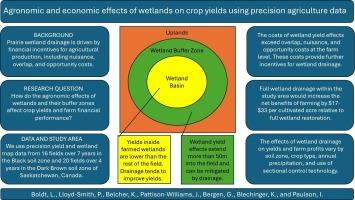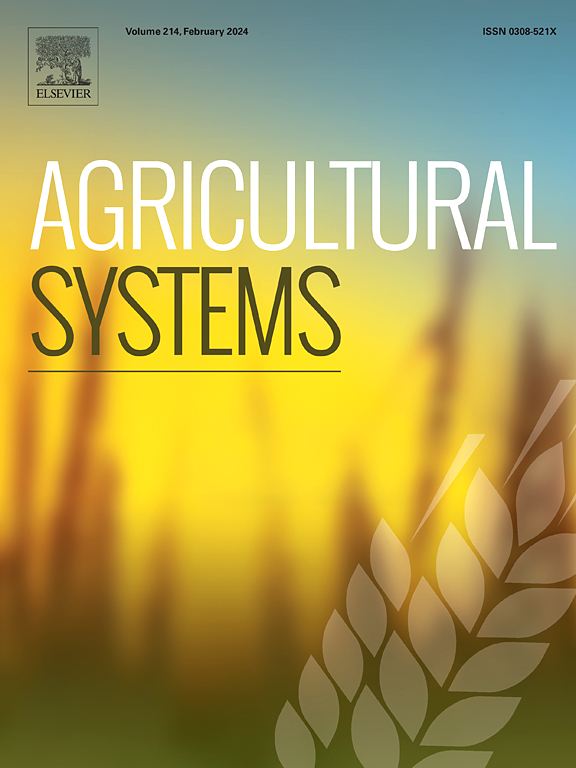利用精准农业数据了解湿地对作物产量的农艺和经济影响
IF 6.1
1区 农林科学
Q1 AGRICULTURE, MULTIDISCIPLINARY
引用次数: 0
摘要
背景湿地排水已成为北美草原洼地地区一个日益重要的保护问题。几十年来,每年农作物生产的经济激励措施推动了湿地排水,而湿地的清除对野生动物栖息地和碳封存等关键湿地生态系统服务产生了不利影响。我们的目标是估算湿地及其缓冲区对作物产量、农场经济效益以及草原洼地地区湿地排水激励措施的影响。我们结合加拿大萨斯喀彻温省黑土区和深棕壤区 36 块田地的精确产量数据和详细的湿地测绘数据,估算湿地及其缓冲区对作物产量的农艺影响。然后,我们将这些产量影响纳入一个包含三种湿地排水方案的农场核算模型中,以估算研究区域湿地排水每年每英亩耕地的净收益,并将这些结果与没有湿地产量影响的估算结果进行比较。结果我们发现,湿地盆地的产量相对低于田地的平均产量,并且与作物类型、土壤区域和年降水量有关,存在很大差异。湿地排水可减轻这些产量影响,但排水湿地盆地的产量仍无法达到田间平均产量。这些产量影响可延伸至湿地边界以外 50 米以上。我们发现,这些影响极大地影响了湿地排水的净效益。如果考虑到产量效应,湿地排水的收益会增加。研究结果表明了在湿地排水决策中考虑湿地和缓冲区产量效应的重要性,提高了我们对湿地成本的认识,并有可能为农业景观中湿地保护的政策制定和激励机制设计提供参考。本文章由计算机程序翻译,如有差异,请以英文原文为准。

Agronomic and economic effects of wetlands on crop yields using precision agriculture data
CONTEXT
Wetland drainage has become an increasingly important conservation issue in the Prairie Pothole region of North America. Financial incentives for annual crop production have driven wetland drainage for decades, and the removal of wetlands has detrimentally impacted key wetland ecosystem services such as wildlife habitat and carbon sequestration. Past studies which model the farmer's decision to drain wetlands often operate on the assumption that drained wetlands will produce similar yields to upland regions of the field.
OBJECTIVE
Our objective is to estimate the effects of wetlands and their buffer zones on crop yields, farm financial performance, and incentives for wetland drainage in the Prairie Pothole Region.
METHODS
We combine precision yield data and detailed wetland mapping data from 36 fields in the Black and Dark Brown soil zones of Saskatchewan, Canada to estimate the agronomic impacts of wetlands and their buffer areas on crop yields. Then, we incorporate these yield effects into a farm accounting model with three wetland drainage scenarios to estimate the annual per cultivated acre net benefits of wetland drainage in the study area, and compare these results to those estimated without wetland yield effects.
RESULTS
We find that yields in wetland basins are relatively lower than the field's average yield, with substantial variability with respect to crop type, soil zone, and annual precipitation. Wetland drainage can mitigate these yield effects, but yields in drained wetland basins still fail to meet the field average yield. These yield effects can extend more than 50 m beyond the wetland boundary. We find that these effects substantially impact the net benefits of wetland drainage. The returns from wetland drainage increase when yield effects are considered. On average, full wetland drainage within the study area increases net benefits by $17 to $33 per cultivated acre relative to full wetland restoration.
SIGNIFICANCE
The results demonstrate the importance of considering wetland and buffer zone yield effects in wetland drainage decisions, improve our understanding of wetland costs, and potentially inform policy development and the design of incentives for wetland conservation in agricultural landscapes.
求助全文
通过发布文献求助,成功后即可免费获取论文全文。
去求助
来源期刊

Agricultural Systems
农林科学-农业综合
CiteScore
13.30
自引率
7.60%
发文量
174
审稿时长
30 days
期刊介绍:
Agricultural Systems is an international journal that deals with interactions - among the components of agricultural systems, among hierarchical levels of agricultural systems, between agricultural and other land use systems, and between agricultural systems and their natural, social and economic environments.
The scope includes the development and application of systems analysis methodologies in the following areas:
Systems approaches in the sustainable intensification of agriculture; pathways for sustainable intensification; crop-livestock integration; farm-level resource allocation; quantification of benefits and trade-offs at farm to landscape levels; integrative, participatory and dynamic modelling approaches for qualitative and quantitative assessments of agricultural systems and decision making;
The interactions between agricultural and non-agricultural landscapes; the multiple services of agricultural systems; food security and the environment;
Global change and adaptation science; transformational adaptations as driven by changes in climate, policy, values and attitudes influencing the design of farming systems;
Development and application of farming systems design tools and methods for impact, scenario and case study analysis; managing the complexities of dynamic agricultural systems; innovation systems and multi stakeholder arrangements that support or promote change and (or) inform policy decisions.
 求助内容:
求助内容: 应助结果提醒方式:
应助结果提醒方式:


